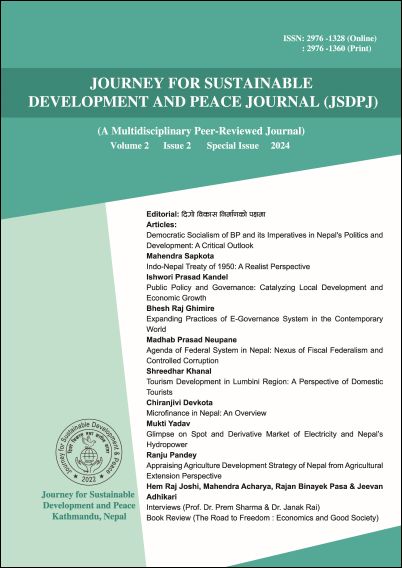Microfinance in Nepal: An Overview
DOI:
https://doi.org/10.3126/jsdpj.v2i2.69573Keywords:
Poverty, microfinance institutions (MFIs), challenges, opportunitiesAbstract
This paper aims to explore the current challenges and opportunities of the microfinance sector in Nepal. The secondary data and descriptive research with a critical approach are adopted to explain the study. The data were mainly collected from Nepal Rastra Bank's (NRB) annual Reports, and other available literature. The result shows that the center numbers (numbers of microfinance user group) change ratio was reduced from 17.11% to 1.30%, the total group numbers were 13% to 2.88%, the borrower 7.51% to (-9.66%), staff progress 9.75% to (-3.48%), loan outstanding 41.18% to (-5.06), profit 150.53% to (-7238), active loan 40.26 to (-7.94), and saving 22.87 to 3.91 between 2020/2021 to 2022/2023. Similarly, the Overdue member change ratio increased upto 53.66%, the passive loan from 79.47% to 104.3%, and the NPL increased continuously from 2.56% to 5.52%. So, all microfinance institutions are in a critical situation in Nepal. However, microfinance is an important concept to reduce poverty and unemployment. Further, it enhances easy access to financial institutions in rural where large banking institutions are merely available. However, microfinance in Nepal is facing critical challenges as many fraud cases are emerging. The policy implication is crucial as policymakers should formulate both long-term and short-term policies and implement those policies immediately in microfinance to revive the critical current situation.
Downloads
Downloads
Published
How to Cite
Issue
Section
License
This license enables reusers to distribute, remix, adapt, and build upon the material in any medium or format for noncommercial purposes only, and only so long as attribution is given to the creator.




